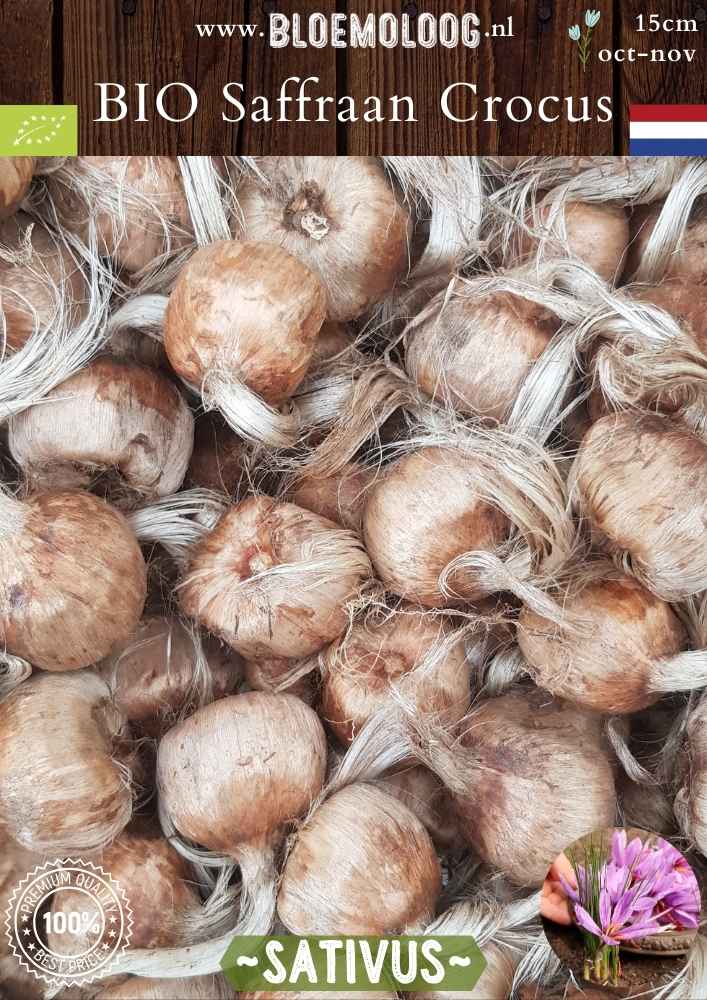Bloemoloog
Organic Crocus sativus XL - Saffron Crocus | 7 pcs.
Organic Crocus sativus XL - Saffron Crocus | 7 pcs.
Estimated Shipping Widget will be displayed here!
Couldn't load pickup availability
Organic Saffron Crocus
Crocus sativus is the only true saffron crocus and a striking beauty in late autumn. It usually blooms from late October into early November when planted freshly, and slightly earlier if bulbs have been in the ground for a year. The flower reaches around 15 cm in height and blossoms in pale purple with bright yellow stamens, making late-season nectar available to pollinators. The red stigmas are the saffron spice. The narrow leaves match the flower height during bloom, continue growing to April, and then die back naturally.
Bloemoloog supplies high-quality bulbs measuring 10–11 cm, sometimes producing two flowers per bulb. And yes, they yield genuine saffron you can cook with! These large bulbs are so vigorous that they may even bloom indoors on a tray without soil or water. However, plant them promptly after flowering to restore their strength.
Do not confuse this saffron crocus with other autumn-blooming species like Crocus speciosus or the toxic Colchicum autumnale.
Culinary Use
Adding saffron to dishes not only imparts a vivid golden hue but also a distinctive flavor. As soon as the flower opens, ideally early in the morning, harvest the red stigmas with tweezers. Dry them in an oven at 50°C for about 15 minutes. Then store the saffron in an airtight jar for one month to fully develop its aroma. Afterwards, it's ready to enhance dishes such as paella, cakes, or soups.
How, Where and When to Plant
Plant saffron crocus bulbs between September and October in groups. The planting depth and spacing should be 2–3 times the diameter of the bulb. Choose a sunny site with at least 6 hours of sunlight per day.
Use nutrient-rich, well-draining soil, preferably loose sandy soil, or at least improved loamy soil. Avoid compacted ground to prevent bulb rot.
Care Instructions
Bulbs can stay in the ground for multiple flowering seasons if not overcrowded. For best results, lift the bulbs in June or July and store them in a warm, dry place like a shed. Replant in September and apply organic fertilizer annually.
Propagation
Crocus sativus does not reproduce by seed because it is a sterile triploid hybrid. New bulbs develop on top of the old ones during flowering and should be separated early in summer for replanting in August or September.
Medicinal Use
Saffron is used for its mood-lifting effects in conditions such as depression, anxiety, obesity, Alzheimer’s disease and certain eye disorders. These health benefits stem from compounds like safranal and crocin. Safranal provides the characteristic aroma and has antidepressant and calming effects. Crocin is a carotenoid pigment with antioxidant and anti-inflammatory properties.
Important: While promising, saffron is not a substitute for medical treatment. Always consult a doctor before using saffron or any herbal supplement as part of a therapeutic plan.
Origin
Crocus sativus is a cultivated hybrid that does not occur in the wild. It likely originated during the Bronze Age on Crete and has been cultivated for thousands of years.
Saffron cultivation spans at least 3,500 years and played a significant role in ancient civilizations.
Meaning of the Name “Saffron”
The Arabic word “asfar” means “yellow,” while “za’farân” means “to dye yellow.” This reflects saffron’s centuries‑old use as both a pigment and spice.
The World’s Most Expensive Spice
Saffron remains one of the most expensive spices worldwide due to its labor-intensive harvest: stigma threads must be hand‑picked from each flower, limiting yield and driving up cost.
Organic Saffron Crocus – Ordering Info
✅ Skal certified: 109459
📦 Packaged in quantities of 7 bulbs, or choose tiered pricing for larger orders!
💰 Tier discount: D
🛒 Delivery in 5 working days
📬 EU Shipping €8.95 – Free shipping from €100 purchase.
Specifications
| Bloom period: | October – November |
| Planting time: | From September |
| Plant depth: | 15 cm |
| Plant spacing: | 10 cm |
| Height: | 15 cm |
| Flower diameter: | 7 cm |
| Light condition: | Full sun |
| Soil type: | Sandy or loamy, neutral to slightly alkaline |
| Hardiness: | Hardy |
| Propagation: | By bulb only (sterile triploid) |
| Origin: | Hybrid |
| Family: | Iridaceae |
| Color: | Lavender with purple veins |
| Bee‑friendly: | Yes |
| Fragrant: | Light scent |
| Bulb size: | 10/11 |
Other crocus varieties

NL‑BIO‑01
To share














